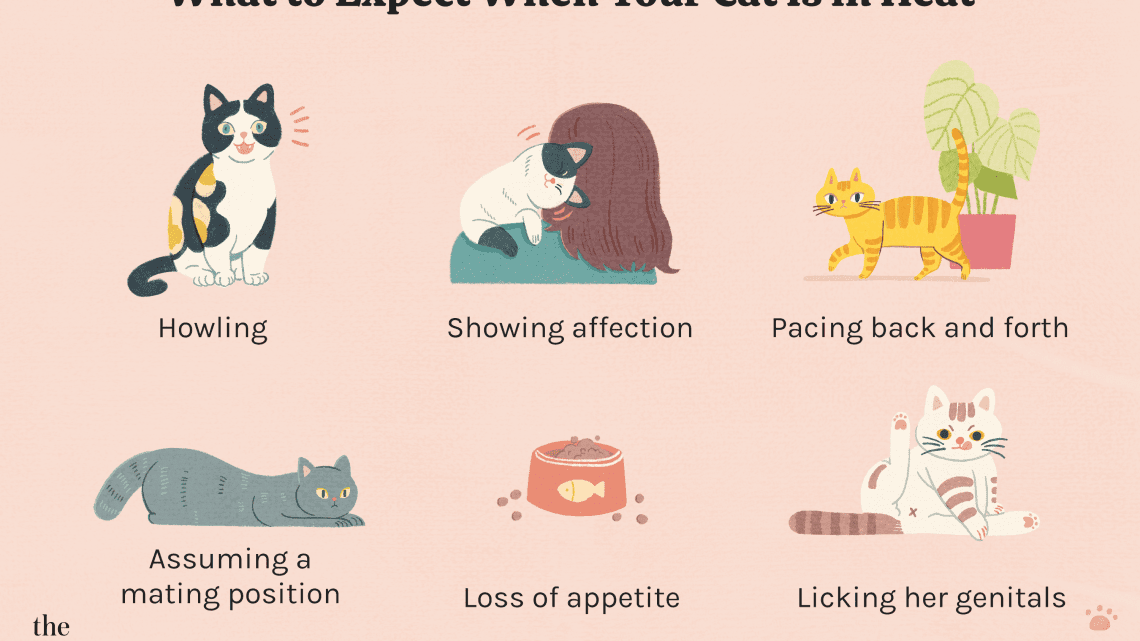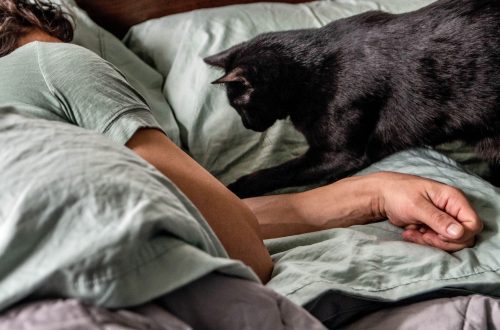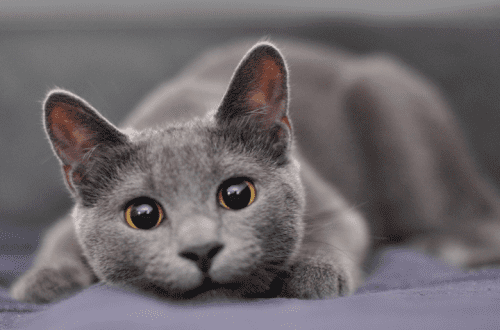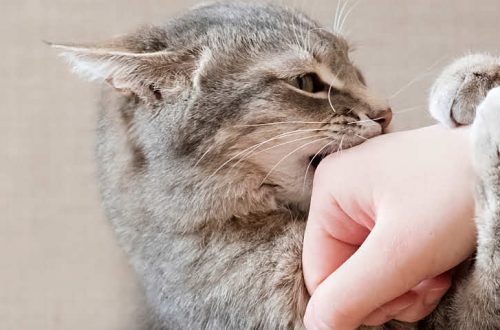
Estrus in cats – how to calm down, when it starts, how long it lasts
Contents
How long does a cat’s heat last?
Each cat goes into estrus in its own way, a period of 5 to 20 days is considered normal. Too short estrus or its absence can be associated with thyroid pathologies and ovarian underdevelopment. If estrus, on the contrary, dragged on, this may be a symptom of inflammation of the ovaries, as well as cysts and tumors.
Important: it is recommended to spay the cat if you do not plan to breed. With a large number of estrus without fertilization, the likelihood of developing diseases of the reproductive system increases, and hormonal drugs that suppress estrus have serious side effects. Sterilized cats do not annoy the owner with inviting meows, do not run away in search of a cat, and live several years longer than pets that have not undergone surgery.
How often does a cat go into heat?
The frequency of estrus in a cat depends on the individual characteristics and breed. For example, the Scottish Fold and the British Shorthair are less likely to go into heat than the more temperamental Persian and Siamese breeds. The average frequency is 1 estrus in 3 months. In some pets, estrus is repeated once every 1 weeks, others are not interested in cats for six months. Thus, the average cat will have 3 heats per year.
If a little predator gave birth and fed kittens, then the next estrus will begin in her in 4-6 months. However, in cases where the offspring was immediately taken away or it died, the cat may be ready to mate earlier.
A cat’s sex drive is affected by age and season. Although estrus accompanies the female throughout her life, in adulthood, rutting occurs more rarely. As for the seasons, increased excitability can be observed from March to October, and decreased excitability in winter. It is so laid down by nature, because it is much easier to bear offspring in the warm period. At the same time, domestic cats living in approximately the same temperature regime may require a cat all year round.
Cat’s first heat
The first estrus in a cat occurs at the age of 6-9 months. In phlegmatic beauties, estrus can begin at 10-16 months. The reason for contacting the veterinarian will be the onset of estrus in a cat under 4 months old or a delay up to one and a half years of age.
The first estrus is not at all a reason to think that now the pet is ready to mate. Physiological maturity occurs approximately six months after puberty, that is, it will be possible to knit a cat at about 1,5 years or older.
For your information: before organizing the mating of a cat, you need to skip 2-3 estrus. Pregnancy in the first heat often ends in complications and the birth of dead kittens, and also stops the development of a young organism.
To predict at what age the first heat in a cat will begin, a few details will help.
- Large cats mature longer than miniature ones, long-haired cats later than short-haired ones. The first estrus in Oriental and Abyssinian cats can happen as early as 5 months, while the Norwegian Forest, Siberian, Maine Coon and Ragdoll will have to wait up to 9-15 months. The estrus in Scottish and British cats begins at 8-12 months.
- Puberty in street cats occurs earlier than in domestic cats.
- The start time of estrus is genetically transmitted. If in the genus of a cat, past generations matured early, then early estrus should be expected.
- Animals with weight problems mature later than their relatives with normal body weight. This applies to both too full cats and females with exhaustion.
- Cats born in spring have been observed to go into heat earlier than cats born in autumn.
- The presence of a nearby cat contributes to an earlier manifestation of sexual instincts.
- If the apartment has poor lighting, the activity of sex hormones will be suppressed, and estrus will come later.
Having estimated at what age to expect the first estrus in a cat, you can plan a future mating or prepare a pet for sterilization.
Signs of heat
Estrus in cats is a natural process that allows the fluffy beauty to fulfill the program laid down by nature – to continue the race. If we compare estrus with the menstrual cycle, then ovulation would be analogous to estrus. Even a not very observant owner will not miss the moment when the pet wants to “go on a spree”. The behavior of the cat changes, which can cause discomfort to households and even neighbors.
It is possible to understand that a cat has started estrus by a number of specific signs.
- The cat requires a lot of attention, becomes affectionate, even obsessive. If you stroke her in the pelvic area, she will take the following pose: she will stretch her front paws forward, and lift her back up, while taking her tail to the side. This position is suitable for mating with a cat. Attacks of tenderness can be replaced by aggression, on such days even the calmest pet is able to hiss and bite.
- The cat begins to actively rub against everything: furniture, carpets, walls, the owner’s legs. Thanks to this, she spreads her scent, which should attract cats.
- An unpleasant feature can be the leaving marks of a cat. While marking objects, the pet turns its back to a vertical surface and raises its tail, releasing a few drops of urine.
- In addition to the smell, males are attracted to the voice. The cat calls the cat with a very loud meow, turning into a scream. It may seem that something terrible has happened to her, because the very timbre of her voice changes, but in fact, the more she yells, the more likely she is to be heard by one of the gentlemen in the district. If during the day you can still put up with this sound accompaniment, then night arias disturb many owners and residents of neighboring apartments.
- During estrus, cats have a clear discharge, so they spend a lot of time licking their genitals.
- Domestic cats will try their best to escape to the street, even if they have never left the apartment before. That’s what instinct tells them. Yard purrs simply do not come into the house during a spree.
- Estrus is accompanied by frequent urination, pets can visit not only the tray, but also other places convenient for them.
- The cat eats less than usual, or because of stress, she completely loses her appetite.
During estrus, a pet experiences great physical and emotional stress. In no case do not punish the cat for inappropriate behavior – it is controlled by hormones. Treat the problem with understanding.
Stages of estrus in cats
The estrus is divided into 4 phases. Even an experienced owner will find it difficult to distinguish one estrus period from another. However, knowing the physiological characteristics of the mustachioed-striped, it will be possible to calculate a favorable date for mating, as well as avoid unpleasant incidents.
- Proestrus. This is the preparatory phase. It lasts from 1 to 4 days. You may notice changes in your cat’s behavior. The pet rolls on the floor, caresses the owner, the first meager discharge appears. At this stage, the female will not let the cat near her, because she is not yet ready for fertilization.
- Estrus. The second stage is called the same as the whole cycle. Heat itself lasts from 5 to 10 days, which largely depends on the breed. Under the increasing action of hormones, it is already difficult for a cat to control its behavior – it screams day and night, and when stroked, it assumes a pose characteristic of mating. Transparent discharge becomes noticeable. Planned mating or spontaneous mating occurs during this phase.
- Interestrus, metestrus or post-oestrus. The third period can take place according to several scenarios, depending on how the previous stage ended. If the cat had mating, during which fertilization occurred, then pregnancy occurs in metestrus, and after 60-70 days kittens will be born. There are cases when conception does not occur during sexual intercourse, and a false pregnancy develops in the pet. This condition in its signs resembles a normal pregnancy, but does not end with childbirth and disappears after 30-45 days. If the cat had no contact with the male, then over the next 2-15 days, the attraction fades away, interest in the opposite sex is replaced by aggression.
- Anestrus. The final phase is called the dormant period. The pet behaves in the usual way. Anestrus can last from 3 weeks to several months. A cat that has given birth will have a longer calm period than a cat that has not found a mate.
How to calm a cat in heat
Each owner, faced with estrus in a cat, thinks about how to help the pet and alleviate its condition. Although, unlike the disease, estrus is a normal physiological process, the fluffy beauty is under great stress. These days, be gentle with your pet and give her enough attention. Try to take her in your arms more often, stroke, talk. These actions do not cancel the symptoms of estrus, but the cat will feel calmer.
Outdoor games will help to sublimate energy. Buy the cat a new toy that would distract her from sexual hunting. Even the simplest items will do – toy mice, tassels and bows. In addition, an exhausted cat is more likely to sleep at night rather than meow. For the same reason, do not let your pet sleep for a long time during the day.
Since appetite decreases during estrus, reduce portions of food, but increase the frequency of feedings. Nutrition must be balanced.
During estrus, some owners are willing to give the cat the opportunity to mate with the cat. When letting a pet out of the house for sexual hunting, you need to be prepared for the appearance of kittens. If breeding is not in your plans, a castrated cat will do, and neuter the animal 2 weeks after estrus.
Sedatives
On the advice of a veterinarian, you can buy special medications to calm the cat (Cat Bayun, Antistress, Stop stress, Fitex). It should be sedatives, not hormones. Herbal preparations relieve emotional stress, and estrus passes more easily. Medicines act gently and are not addictive. The choice of a specific brand and dosage is made by a veterinarian after consultation with a description of all the symptoms. Each cat reacts to sedative drops differently, as is the case with valerian.
Hormonal preparations
You can interrupt the heat by giving the cat hormonal drugs, but this is an extreme measure, which can be resorted to a maximum of 2 times a year. Moreover, experts generally do not recommend the use of drugs with the effect of “antisex” due to a number of side effects. Hormonal disruptions caused by drops can provoke inflammatory processes in the genital organs, cysts, malignant tumors, diabetes, and adrenal dysfunction. Don’t resort to heavy artillery without good reason.
In 70% of cases, regular and prolonged use of hormonal drugs that interrupt estrus leads to castration of a cat for medical reasons in adulthood. Even if the cat has good health, you should not risk it.
What not to do
- Do not scold or punish the animal for unwanted behavior – meowing, obsession and leaving marks. The cat does all this not out of harm, so nature takes its toll. The fluffy purr herself would be happy to curl up and sleep.
- Some sources advise bathing a cat or dousing it with water, but in fact, these actions will only become additional stress for the pet. The next half hour of her licking isn’t worth it.
- Another stereotype is that if you lock the purr in a dark room, then estrus will pass faster. This is due to the effect that the sun’s rays have on the hormonal system. But we must not forget that being in a dark enclosed space will make the cat nervous, up to the development of her mental disorders.
Heat in a sterilized cat
Many owners of mustachioed-striped think about sterilization or castration of a cat. A lot of myths and discrepancies arose around these operations. Even to such a key question: “Will the cat go into heat after sterilization?” – you can see different answers. Let’s figure it out.
Speaking of operations to prevent reproduction, castration and sterilization are distinguished. During sterilization, the cat’s fallopian tubes are tied, and the seminal ducts are tied for the cat. The animal will not be able to become a parent, but the production of hormones and sexual instincts are preserved. Thus, spayed cats remain in heat. During castration, the sex glands, and sometimes the uterus, are removed. Accordingly, a castrated cat will not be in heat, and the cat will not mark the territory and go on a sexual hunt. To simplify, castration of a cat is often called sterilization, however, when signing up for an operation at a veterinary clinic, you need to understand what effect you want to get from the procedure.
Modern clinics offer operations with laparoscopic access. Instead of incisions, small punctures are made on the cat’s abdomen, thanks to which the sterilization takes place in a gentle manner, and the pet quickly recovers.
There are 3 main types of operations, the first of which is essentially sterilization, and the other two are castration.
- tubal occlusion. The cat’s fallopian tubes are tied up so that she can’t get pregnant. This method is rarely used today, since regular estrus with all the ensuing consequences persist, there is a risk of inflammation of the uterus.
- Ovariectomy. During surgery, the cat’s ovaries are removed. The estrus stops, plus the pet will not have polycystic disease and tumors in the mammary glands in the future. At the same time, the uterus remains unchanged, this organ is not immune from diseases.
- Ovariohysterectomy. This operation completely prevents inflammatory processes in the reproductive organs of the cat and consists in the simultaneous removal of the ovaries and uterus. As in the previous case, there will be no estrus.
Can a cat be spayed while in heat?
When a pet starts estrus, you want to quit everything and immediately take it to the veterinarian for surgery, but sterilization is carried out only during the period of sexual dormancy. You need to wait 2 weeks after the end of estrus, or guess the time 2 weeks before the next estrus.
If the purpose of the operation is to prevent breast cancer, cats are spayed before the first estrus, at 6-8 months of age. Pet must weigh at least 3 kg.
If there is no threat of oncology, veterinarians most often recommend spaying the cat after the first estrus, because it is very difficult to guess when exactly these days will begin for the first time. In case of non-compliance with the 2-week interval, the intervention in the hormonal system of the cat will be too rough.





